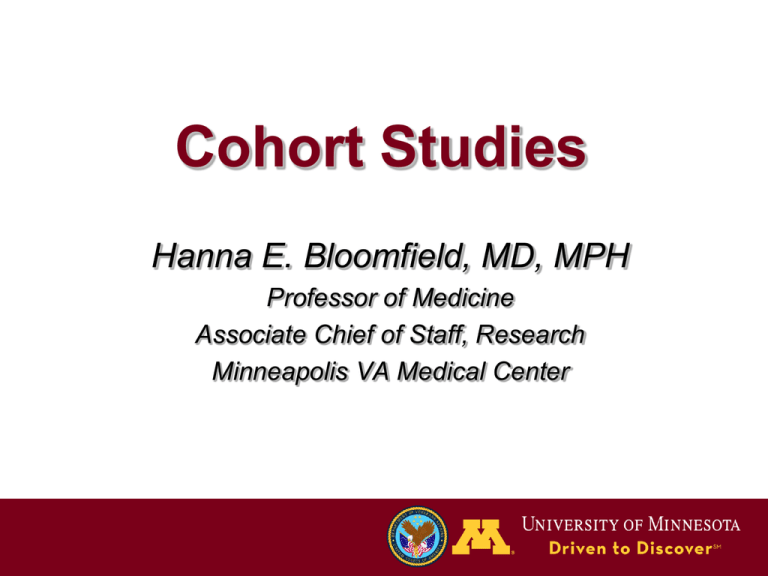Cohort Studies & Randomized Clinical Trials
advertisement

Cohort Studies Hanna E. Bloomfield, MD, MPH Professor of Medicine Associate Chief of Staff, Research Minneapolis VA Medical Center Disclosure • I have no financial relationships to disclose. • I will not discuss off label use and/or investigational use in my presentation Empowering Evidence 2014 Learning Objectives By the end of this session participants should understand • The difference between a prospective and retrospective cohort study • The difference between a cohort and a case control study • The concept of bias • The concept of confounding Empowering Evidence 2014 Evidence Pyramid Increasing strength of evidence for clinical application Clinical, Epidemiologic, Health Services Basic Science Empowering Evidence 2014 Cohort Studies • Overview • How they differ from Case Control Studies • Bias • Confounding • Characteristics of a GOOD cohort study Empowering Evidence 2014 Cohort Studies May be used to study… • Etiology/ Risk Factors/Prognosis • Effect of Treatments – Hypothesis generating! • May be either – Prospective – Retrospective Empowering Evidence 2014 Prospective Cohort Study To evaluate Etiology/Risk Factors/Prognosis Risk Factor population Follow-up 1000 High blood pressure Outcome 60 Heart Attacks sample 1000 Normal blood pressure 20 Heart Attacks Study begins here PRESENT, 2014 Empowering Evidence 2014 FUTURE, 2014-18 Retrospective Cohort Study To evaluate Etiology/Risk Factors/Prognosis Risk Factor population Follow-up 1000 High blood pressure Outcome 60 Heart Attacks sample 1000 Normal blood pressure 20 Heart Attacks You act as if study begins here PAST, 2008 Empowering Evidence 2014 PRESENT, 2014 Cohort Study To evaluate Treatment Hypothesis generating only Risk Factor Population of middle sample age people with high blood pressure Follow-up 1000 on treatment 1000 not on treatment Outcome 60 Heart Attacks 20 Heart Attacks Study begins here PRESENT, 2014 Empowering Evidence 2014 FUTURE, 2014-18 Cohort Studies • • • • • Overview How they differ from Case Control Studies Bias Confounding Characteristics of a GOOD cohort study Empowering Evidence 2014 Case Control Studies To evaluate Etiology/Risk Factors 60% High blood pressure 20% High blood pressure 1000 Prior Heart Attack 1000 No Prior Heart Attack Study begins here PAST Empowering Evidence 2014 PRESENT, 2014 Case Control Studies To evaluate Treatment Efficacy 20% On Aspirin 60% On Aspirin 1000 Prior heart attack 1000 No prior heart attack Study begins here PAST Empowering Evidence 2014 PRESENT, 2014 Cohort v. Case Control • Cohort (either prospective or retrospective) – Subjects are defined by risk factor/treatment status – Disease occurrence in the future is then assessed and compared • Case Control – Subjects are defined by disease status – Past history of risk factor/treatment are then assessed and compared Empowering Evidence 2014 Cohort Studies • • • • • Overview How they differ from Case Control Studies Bias Confounding Characteristics of a GOOD cohort study Empowering Evidence 2014 Bias and Confounding • Two problems that can undermine validity of cohort studies • Bias – Systematic error in the design, conduct, or analysis of a study • Confounding – It looks like Factor A causes Disease X but in fact it is Factor B Empowering Evidence 2014 Bias • There are a million types of bias!! • Some common ones to look for… – Selection bias – Information bias Empowering Evidence 2014 Selection Bias: example To evaluate Etiology/Risk Factors population 1000 High blood pressure 60 Heart Attacks sample 1000 Normal blood pressure • HBP recruited from a cardiology clinic • Normal BP from a primary care clinic • What’s wrong with this picture?? Empowering Evidence 2014 20 Heart Attacks Selection Bias • Systematic difference in prognostic or treatment factors between the 2 groups • In our example…. – One group is more likely to have more cardiac risk factors or history than the other – One group is more likely to be aggressively treated than the other (eg lipids) Empowering Evidence 2014 Information Bias To evaluate Etiology/Risk Factors population 1000 High blood pressure 60 Heart Attacks sample 1000 Normal blood pressure 20 Heart Attacks • Heart Attack incidence is measured from hospital records in one group and from patient recall in another • What’s wrong with this picture?? Empowering Evidence 2014 Bias • Systematic error in the design, conduct, or analysis of a study • The question to ask yourself when reading a study: Did they do things differently between the 2 groups? – Recruitment? Treatment? Follow-up? Ascertainment of Endpoints? Analysis of Data? Empowering Evidence 2014 Confounding • This is the main problem in ALL observational studies • Bias is under control of investigators – Did they do things differently between the 2 groups? • Confounding is NOT under the control of the investigators – It is endemic to observational studies – But it can be mitigated Empowering Evidence 2014 We do this cohort study… To evaluate Etiology/Risk Factors population 1000 High blood pressure sample 1000 Normal blood pressure 60 Heart Attacks P<0.001 20 Heart Attacks • We have done a good job controlling for bias • We find a significant association between a history of HBP and risk of heart attack • Is that the end of the story? Empowering Evidence 2014 We still don’t know if… • Its the high BP that increases the risk of heart attack or something else (that frequently accompanies HBP) that is actually the culprit • In other words, is there “confounding”? Empowering Evidence 2014 Confounding in Risk Factor/Etiology Studies High Blood Pressure Risk factor Heart Attacks Outcome Before we can definitively say that high blood pressure is a risk factor for heart attacks, we need to rule out confounding Empowering Evidence 2014 Population: Middle Aged People in the US sample No HBP 20 heart attacks Empowering Evidence 2014 HBP 60 heart attacks Population: Middle Aged People in the US sample No HBP Don’t Smoke Exercise Have normal cholesterol 20 heart attacks Empowering Evidence 2014 HBP Smoke Don’t Exercise Have high cholesterol 60 heart attacks Confounding in Risk Factor/Etiology Studies High Blood Pressure Risk factor Heart Attacks Outcome High Cholesterol Confounding Variable A variable that is associated with both the risk factor and the disease Empowering Evidence 2014 Confounding in Treatment Studies Treatment of High Blood Pressure Empowering Evidence 2014 Heart Attacks Population: Middle Aged People in the with HBP sample HBP treated HBP Not treated 20 heart attacks 60 heart attacks Empowering Evidence 2014 Population: Middle Aged People in the with HBP sample HBP treated Get other Interventions e.g. aspirin 20 heart attacks Empowering Evidence 2014 HBP Not treated Don’t get other interventions 60 heart attacks Confounding • A problem in even the most meticulously conducted cohort study • There are ways to mitigate its effects – Have all the likely confounders been identified? – Have the authors used appropriate statistical techniques for dealing with potential confounders? Empowering Evidence 2014 Confounding • But it can never be totally ruled out in an observational study (cohort, case-control) • You can deal with the known confounders – “control for”, “adjust for” them • But you can’t deal with the unknown, unmeasured ones Empowering Evidence 2014 Confounding • The only way to avoid confounding is to do a randomized trial – Randomization balances the known and unknown risk factors evenly between the two groups • Treatment decisions (especially for prevention) should be based on randomized trial data Empowering Evidence 2014 Cohort Studies • • • • • Overview How they differ from Case Control Studies Bias Confounding Characteristics of a GOOD cohort study Empowering Evidence 2014 Features of Good Cohort Studies • Sample representative and assembled at a common point in time • Follow-up sufficiently long and complete • Outcome criteria objective or applied in a blinded fashion • Adjustment for possible confounding (prognostic factors) • Results reported with time to event curves (if f/u longer than a few months) • Precision of the effect size reported (CI) Empowering Evidence 2014 Small Group Exercise Glucose Levels and Risk of Dementia Crane et al NEJM 2013; 369(6):540-548 Start by reading the abstract …Then try to answer these questions • • • • • • • What kind of study was this? Was follow-up sufficiently long and complete? Were the outcome criteria objective or applied in a blind fashion? Was adjustment for prognostic factors (confounding) done? Were outcomes reported over time (ie time to event analysis)? How precise were the estimates of prognosis? How would you apply the results of this study in your practice? Empowering Evidence 2014







